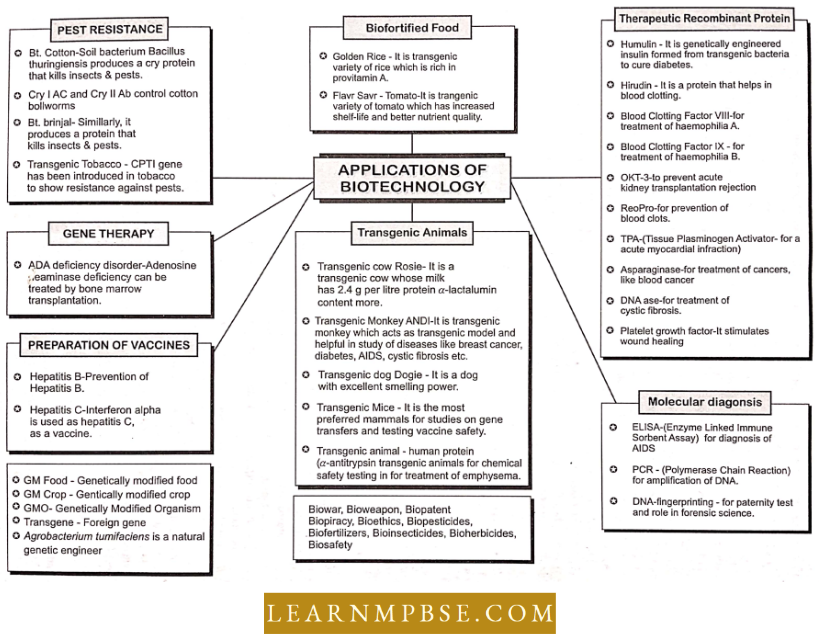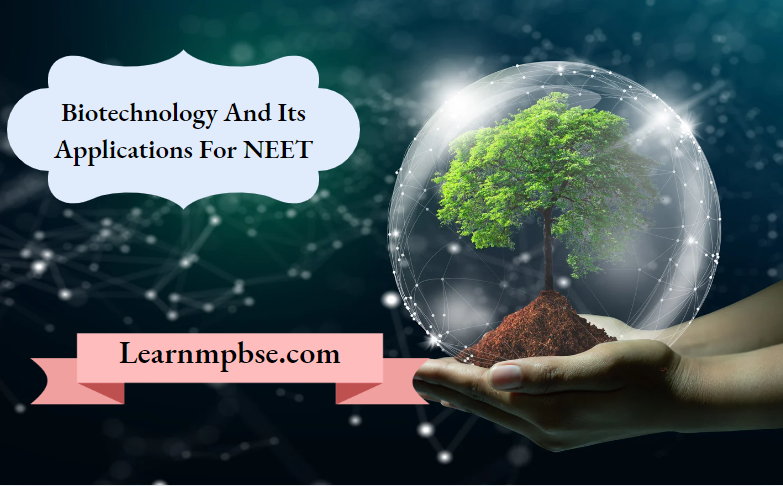Biotechnology And Its Applications For NEET
Biotechnology can be defined as the use of microorganisms, plain and animal cells for commercial-scale production of biopharmaceuticals and for human welfare.
The Applications Of Biotechnology Include:
- Therapeutics
- Diagnostics
- Genetically modified crops for agriculture
- Processed food
- Bioremediation
- Energy production and
- Waste treatment
The Three Critical Research Areas Of Biotechnology Are:
- Providing the best catalyst in the form of an improved organism, usually in the form of a microbe or pure enzyme.
- Creating optimal conditions through engineering for a catalyst to function.
- Downstream processing technologies to purify the protein/organic compound for marketing.
Read and Learn More NEET Biology Notes
Applications Of Biotechnology In Agriculture For NEET
The Three Options For Increased Food Production Are:
- Agrochemical-based agriculture.
- Organic agriculture and
- Genetically engineered crop-based agriculture.
The Green Revolution succeeded in increasing the yield of crops mainly due to
- Use of improved varieties of crops and
- Use of agrochemicals (fertilizers and pesticides).
- Further increases in the yield with the existing varieties of crops are not possible using conventional methods of breeding.
- Agrochemicals cause soil and water pollution and are too expensive for farmers.
Biotechnology And Its Applications Neet Notes
Genetically Modified Crops:
A transgenic crop incorporates and expresses a transgene. A prevalent designation for transgenic crops is genetically modified crops, or GM crops.
The methodologies employed in the cultivation of transgenic crops provide two distinct advantages:
- Any gene, whether derived from an organism or manufactured chemically, can be utilized for transfer
- The alteration in genotype can be meticulously regulated since only the transgenic is incorporated into the crop genome.
Genetically Modified Crops Contrasting Breeding Activities:
- Only genes existing in specific species can undergo hybridization within those species.
- Alterations arise in all qualities for which the parental organisms utilized in hybridization exhibit differences.
- Upon the introduction of a transgene into an organism’s genome, it may accomplish one of the following outcomes:
- Generates a protein that is the subject of our interest.
- Generates a protein that independently manifests the desired trait.
- Alters an established metabolic pathway to provide a novel end product.
- Inhibits the expression of a pre-existing native gene.
Hirudin is a protein that inhibits coagulation. The gene that encodes hirudin was produced chemically. The gene was subsequently introduced into Brassica napus, resulting in the accumulation of hirudin in the seeds. Hirudin is refined and utilized as a pharmaceutical agent. The transgene product is the primary focus of interest.
The ‘Flavr Savr’ tomato variety exemplifies the suppression of a native tomato gene’s expression. The expression of a native gene can be inhibited by many techniques.
The enzyme polygalacturonase facilitates fruit softening by degrading pectin.
- The transgenic tomato cultivar ‘Flavr Savr’ exhibited a cessation of polygalacturonase production.
- Consequently, the fruits of this tomato variety maintain freshness and preserve their flavor significantly longer than those of other tomato types.
- Furthermore, the fruits exhibit an enhanced flavor and elevated total soluble solids, which serve as an unforeseen advantage.
The final two elements are under investigation through various tests prior to arriving at a definitive conclusion.
Genetically Modified Food:
The food prepared from the produce of genetically modified (= transgenic) crops is called genetically modified food, or in short, GM food. GM food differs from the food prepared from the produce of conventionally developed varieties mainly in the following aspects.
- Genetically modified food contains the protein produced by the transgene in question, for example, Cry protein in the case of insect resistance varieties.
- Genetically modified food contains the enzyme produced by the antibiotic resistance gene that was used during gene transfer by genetic engineering.
- Genetically modified food contains the antibiotic resistance gene itself.
- Genetically modified food t has been argued that the above features of GM foods could lead to the following problems when they are consumed. Firstly, the transgene product may cause toxicity and/or produce allergies. Secondly, the enzyme produced by the antibiotic resistance gene could cause allergies, since it is a foreign protein.
- Finally, the bacteria in the alimentary canal of humans could take up the antibiotic resistance gene in GM food. These bacteria would then become resistant to the concerned antibiotic. As a result, these bacteria could become difficult to manage.
The scientists involved in the production of transgenic crops are addressing to these concerns. Efforts are being made to use other genes in place of antibiotic resistance genes. The toxic and allergenic actions of the transgene product can be adequately examined by detailed assays using suitable animal models.
Biotechnology For NEET GM Products Benefits And Controversies
GM Products Benefits And Controversies Benefits
- Crops
- Enhance taste and quality
- Reduced maturation time
- Increased nutrients, yields, and stress tolerance
- Improved resistance to disease, pests, and herbicides
- New products and growing techniques.
- Animals
- Increased resistance, productivity, hardiness, and feed efficiency
- Better yields of meat, eggs, and milk
- Improved animal health and diagnostic methods.
- Environment
- “Friendly” bioherbicides and bioinsecticides
- Conservation of soil, water, and energy
- Bioprocessing for forestry products
- Better natural waste management
- More efficient processing.
- Society: Increased food security for growing populations.
GM Products Benefits And Controversies Controversies Safety:
- Potential human health impact
- Allergens, transfer of antibiotic resistance markers, unknown effects
- Potential environmental impact
- Unintended transfer of transgenes through cross-pollination, unknown effects on other organisms (for example, soil microbes), and
- Loss of flora and fauna biodiversity
Biotechnology And Its Applications Neet Notes
Biotechnology For NEET Applications Of Genetically Engineered Microbes
Nif genes, Found in Rliizobiuin leguminosarum may be transferred to major food crops to increase food production without using expensive fertilizers
Introduction Of Gene For Coding: Vitamins, antibiotics, and hormones from higher animals to bacteria—thus Bacteria will act as living factories.
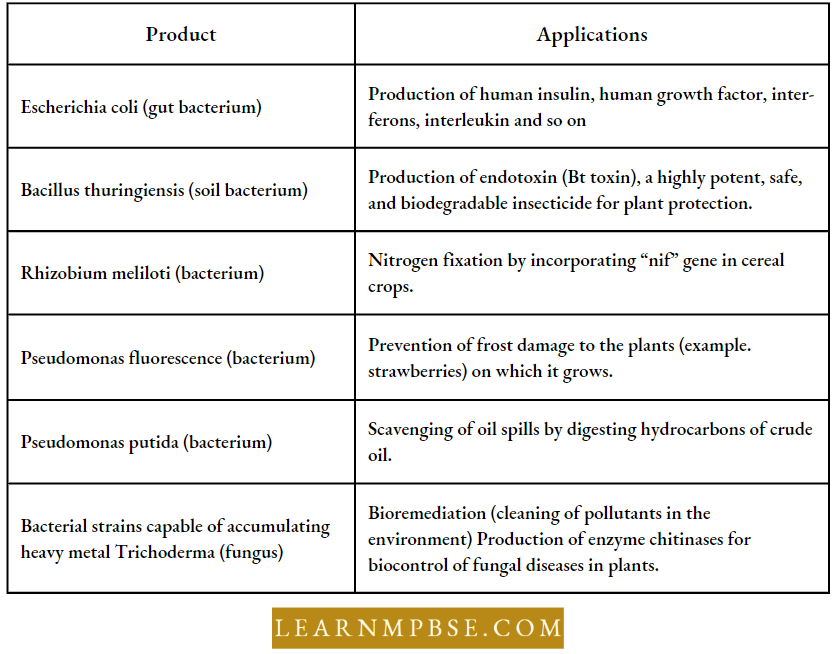
Production Of Pest Resistant Plants Bt Cotton.
The soil bacteria Bacillus thuringiensis synthesizes crystal proteins known as Cry proteins, which are lethal to the larvae of insects such as tobacco budworms, armyworms, beetles, and mosquitoes.
- The Cry proteins are present as inactive protoxins and are transformed into active toxins upon ingestion by the insect, as the alkaline pH of the stomach solubilizes the crystals.
- The active toxin adheres to the epithelial cell surface of the midgut and forms pores.
- This induces cellular swelling and lysis, resulting in the insect’s (larva’s) demise.
- The cry genes that encode this protein are extracted from the bacterium and integrated into several crop plants like as cotton, tomato, corn, rice, and soybean.
- The proteins expressed by the specified cry genes regulate the corresponding pest resistance.
- Cry 1 Ac and Cry 2 Ab regulate cotton bollworm populations.
- Cry 1 Ab regulates the borer.
- Cry 3 Ab targets the Colorado potato beetle, while Cry 3 Bb targets the corn rootworm.
Protection Against Nematodes
- A nematode Meloidogyne incognita infects tobacco plants and reduces their yield.
- The specific genes (in the form of cDNA) from the parasite are introduced into the plant using Agrobacterium as the vector.
- The genes are introduced in such a way that both sense/coding RNA and antisense RNA (complementary to the sense/coding RNA) are produced,
- Since these two RNAs are complementary, they form a double-stranded RNA (ds RNA).
- This neutralizes the specific RNA of the nematode, by a process called RNA- interference.
As a result, the parasite cannot live in the transgenic host and the transgenic plant is protected from the pest.
- Tomato resistant to Homeworm larvae.
- Similarly Tobacco, Populus, etc. with the help of Agrobacterium tumefaciens
- Transgenic potato and tobacco plants that produce human serum albumin (USA)
- Transgenic potato plants, with increased levels of cyclodextrins.
- Transgenic tobacco plants with increased levels of mannitol
- Transgenic plant for hybrid seed production.
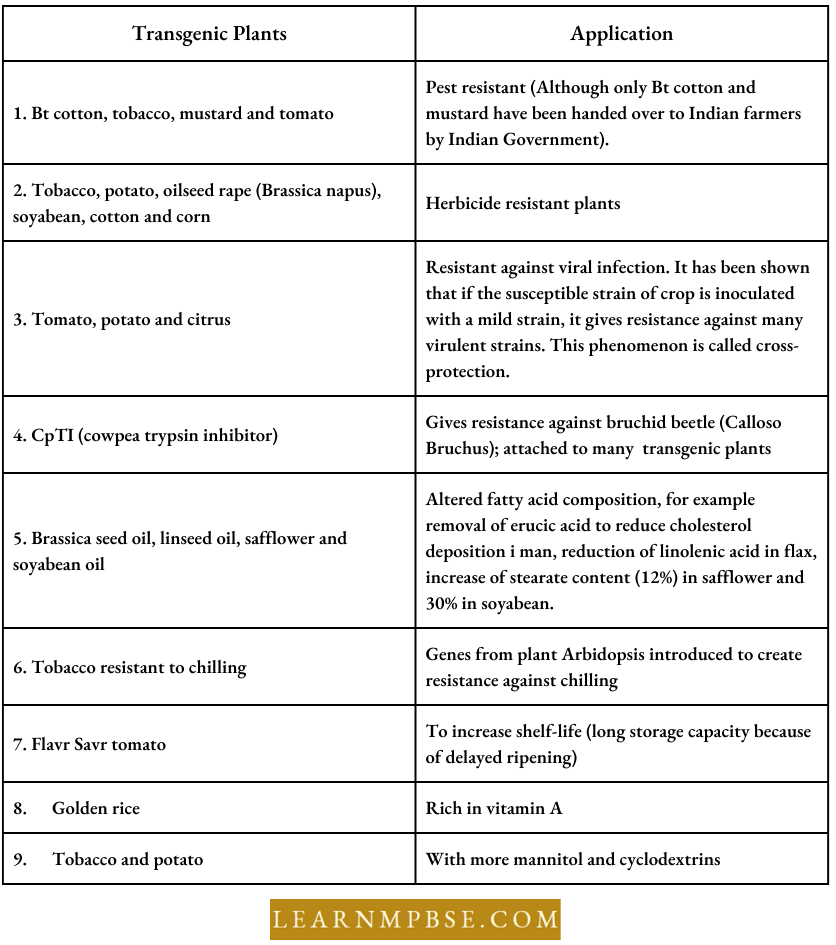
Genetically Modified Food:
A tomato called Flavr Savr has been created to have a better flavourful shelf-life. It is due to delayed ripening.
This has been achieved in reducing the contents of cells with a degrading enzyme called as polygalacturonase which leads to tomato fruit ripening. Another example of transgenic modified food is transgenic rice with higher vitamin A contents.
Transgenic Animals:
We can produce new animals and human beings, having traits tailored according to our own will.
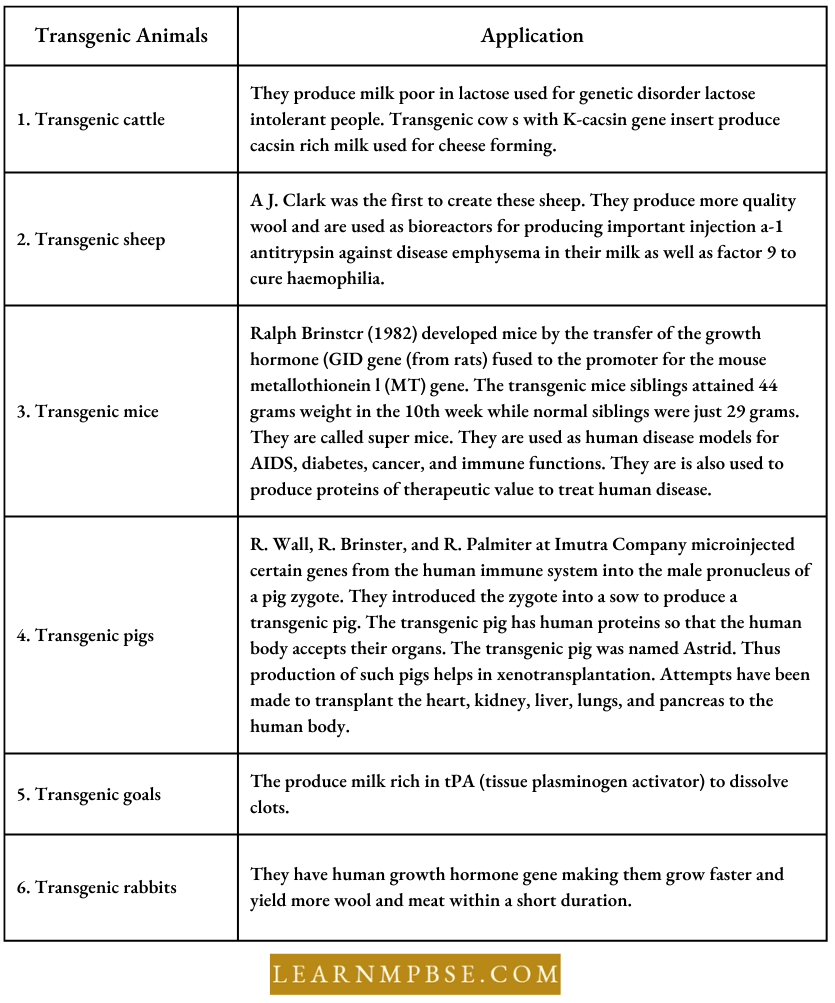
Biotechnological Applications For NEET In Medicine
Therapeutic Agents: Proteins with potential as pharmaceutical agents are produced by using genetically engineered organisms. Enzymes have also been used for this purpose, for example, DNase 1 and alginate lyase have been used in aerosols. Some known examples are given below:
- Human growth hormone obtained from E. coil is used for the treatment of dwarfs.
- Chorionic gi nadotropin hormone produced by genetic engineering is used for the treatment of infertility.
- Interferons produced by E. coli are commercially used for the treatment of viral infections and cancer. Interferons were first obtained through DNA recombinant technique by Charles Weisman in 1980. He inserted the gene for interferon production in E. coli.
- Interleukins produced by E. coli are used to stimulate the immunity system.
- Tissue Plasminogen Activator (TPA) – an enzyme is used for dissolving blood clots after a heart attack and stroke.
- Antihemophilic human factor 8 is used by people with hemophilia to prevent and control bleeding or to prepare them for surgery.
- Platelet-derived growth factor produced by recombinant DNA technology is useful for stimulating wound healing.
- Penicillin G acylase is also produced by genetic engineering. This enzyme is used for converting penicillin into 6- 6-amino penicillin acid for the formation of new antibiotics.
Biotechnology And Its Applications Neet Notes
Molecular Diagnosis: Recombinant DNA molecules and techniques like PCR (Polymerase Chain Reaction; are used for early diagnosis of disorders.
- Cloned genes when expressed to produce recombinant proteins, help in developing sensitive diagnostic techniques like ELISA.
- The cloned genes are also used as ’probes’ to detect the presence of complementary DNA strands.
- A probe is a piece of single-stranded DNA that is tagged with a radioactive molecule and it is used to find its complementary DNA by hybridisation.
- It is followed by the detection of radioactivity by autoradiography.
- The presence of a normal or mutant gene can be detected using such a method.
- PCR is used to detect HTV and to detect mutations in genes.
Biotechnology For NEET Genetically Engineered Insulin (Humulin)
Human insulin consists of so short polypeptide chains: chain A and chain B linked by disulfide bridges.
- Insulin is secreted as prohormone which has to be processed before it becomes a mature and functional hormone.
- The prohormone contains another polypeptide called C-peptide, which is removed during maturation.
Gene For Coding Insulin: From humans to bacteria is transferred and the insulin produced is called Humulin. In 1983. American Company Eli Lily produced genetically engineered Insulin called Humulin with the help of E. coli—Plasmid clone.
- In 1983, Eli Lilly, an American company, prepared two DNA sequences coding for chains A and B of human insulin and introduced them into the plasmids of Escherichia coli to produce insulin.
- The two chains produced were extracted and combined by creating disulfide bridges.
Biotechnology For NEET Gene For Preparing Interferon
Charles Weismann produced interferon through recombinants of E. coli. Production of transgenic plants for preparing recombinant products.
Many viral, bacterial, and protozoan vaccines are being synthesized through the technique of genetic engineering. These synthetically produced vaccines are the latest ones used in immunization. The gene coding for antigen protein is isolated from the pathogen and is cloned in bacterial host cells.
The social, economic, and environmental implications of genetic engineering techniques.
- Generally prepared human insulin and edible vaccines will be readily available and also will be economical.
- Transgenic crop plants for human consumption may cause concerns about safety due to unwanted properties they may have.
- Hence the Indian Government has set up organizations that are authorized to make decisions regarding the validity of genetic modifications and the safety of introducing genetically modified organisms for public sendees.
- One such organization is the Genetic Engineering Approval Committee (GEAC).
- Some people believe that transgenic plants and animals can solve many human problems, especially of hunger and disease.
Biotechnology For NEET cDNA Library
The copy of DNA formed on mRNA is called cDNA. 1,000 – 30,000 types of various mRNA sequences can be obtained from a typical eukaryotic cell.
- cDNA library and cDNA clone bank are the populations of such viruses where each virus has at least one cDNA inserted plasmid is present.
- In a complete viral population, each member has from outside DNA sequence.
- It is easy to make a clone bank of those viruses that have DNA as genetic material, for example, the Influenza virus and Reovirus, etc.
- Prokaryotic gene has no introns, so cDNA is the continuous copy of mRNA while in Eukaryotes introns break the DNA molecules in small segments called exons.
Single Cell Proteins (SCP). Cells from different kinds of organisms such as bacteria, filamentous fungi, yeast, and algae are treated in different ways so that they are used as food or feed, and are called single cell protein.
The biomass is obtained from both mono and multicellular micro-organisms. The common substrate used for preparing such food containing SCP ranges from air, whey, sawdust, and paddy straw. SCA provides a valuable protein supplement in the human diet.
Biotechnology Mcq For Neet
Advantages Of Introducing Transgene
- Formation of a desired protein.
- Produces a protein that on its own produces the desired phenotype.
- Modifies an existing biosynthetic pathway so that a new end product is obtained.
- Prevents the expression of an existing native gene.
For example, Hirudin is a protein that prevents blood clotting. The gene encoding for hirudin was chemically synthesized’’ This gene was then transferred into Brassica napus. where hirudin accumulates in seeds. The hirudin is purified and used as medicine. In this case, the transgene product itself is the product of interest.
Biofertilizers: These are organisms that can bring about soil nutrient (like nitrogen or phosphorus) enrichment. The main sources of biolertilizers are bacteria, cyanobacteria, and fungi. Rhizobin from root nodules in legumes and cyanobacteria from symbiotic association with the form Azolla. The fungus and plant root association is termed mycorrhiza.
- They Are The Following Advantages Thus Preferred To Chemical Fertilizers:
- They are safe and moreover do not pollute the atmosphere.
- The surface runoff does not pollute water.
- They do not disturb the naturally occurring food chains.
- They are of low cost as compared to chemical fertilizers and pesticides.
- They do not cause any danger to the natural resources.
- Pesticides are poisons and non-specific in their target. They also kill useful predators and upset the natural balance.
Biopesticide involves the biological control of weeds, insects, and pathogens by some living organisms. It involves the use of insects feeding on a specific weed or the use of certain microorganisms viruses, bacteria, fungi, protozoa, or mites which will cause disease in weeds.
- The first bioherbicide was developed in 1961 and it was a mycoherbicide derived from the fungus Phytophthora palmivora which controls the growth of milkweed vines in citrus orchards.
- Another fine example of biological control of weeds is the control of overgrowth of cacti by the introduction of a cochineal insect (Cactoblastis cactorum) in India and Australia.
Applications Of Biotechnology Neet Questions
A few Examples Of Biopesticides Are: Biochemical active ingredients
- Plant Volatile And Floral Attractants
- Lemon grass oil
- Eucalyptus oil
- Mustard oil (Allyl isothiocyanate)
- Geranium oil
- Citronella oil
- Natural Insect Growth Regulators
- Dihydroazadirachtin
- Azadirachtin.
- Biological products Transgenic animals that produce useful biological products can be created by the introduction of the portion of DNA that codes for a particular product such as human proteins (α-antitrypsin) used to treat emphysema.
- Similar attempts are being made for the treatment of phenylketonuria and cystic fibrosis. In 1997, the first transgenic cow, Rosie, produced human protein-enriched milk (2.4 g/L). The milk contained human alpha-lactalbumin and was nutritionally a more balanced product for human babies.
- Vaccine safety Transgenic mice are being developed for use in testing the safety of vaccines before they are used on humans. Transgenic mice are being used to test the safety of the polio vaccine.
- Chemical safety testing Transgenic animals are made that carry genes that make them more sensitive to toxic substances than non-transgenic animals. They are then exposed to the toxic substances and the effects studied. Toxicity testing in such animals will allow us to obtain results in less time.
Biopesticide Ethical Issues
- The manipulation of living organisms by the human race cannot go on any further, without regulation.
- Some ethical standards are required to evaluate the morality of all human activities that might help or harm living organisms.
- Going beyond the morality of such issues, the biological significance of such things is also important. Genetic modification of organisms can have unpredictable results when such organisms are introduced into the ecosystem.
- Therefore, the Indian Government has set up organizations such as GEAC (Genetic Engineering Approval Committee), which will make decisions regarding the validity of GM research and the safety of introducing GM organisms for public services.
The major bioethical concerns connected with exploits of biotechnology are
- The use of animals in biotechnology causes great suffering to them.
- When animals are used for the production of pharmaceutical proteins, they are virtually reduced to the status of a factory.
- The introduction of a transgene from one species into another species violates the integrity of the species.
- The transfer of human genes into animals (and vice-versa) dilutes the concept of humanness.
- Biotechnology is disrespectful to living beings and only exploits them for the benefit of human beings.
- Biotechnology may pose unforeseen risks to the environment, including risks to biodiversity.
Biological Resources Or Bioresources:
Biological Resources Or Bioresources include all those organisms that can be used to derive commercial benefits. Traditional knowledge related to bioresources is the knowledge developed by various communities over long periods of history, regarding the utilization of bioresources, for example, the use of herbs, etc. as drugs.
Often, this traditional knowledge can be exploited to develop modern commercial processes. The traditional knowledge suggests the direction to be followed and saves considerable time, effort, and expenditure for their commercialization. Institutions and companies of industrialized nations are collecting and exploiting the bioresources, as follows.
- They are collecting and patenting the genetic resources themselves. For example, a patent granted in the U.S.A. covers the entire ‘basmati’ rice germplasm indigenous to our country.
- The bioresources are being analyzed for the identification of valuable biomolecules. A biomolecule is a compound produced by a living organism. The biomolecules are then patented and used for commercial activities.
- Useful genes are isolated from the bioresources and patented. These genes are then used to generate commercial products.
- The traditional knowledge related to bioresources is utilized to achieve the above objectives. In some cases, the traditional knowledge itself may be the subject of a patent.
A west African plant, Pentadiplcmdra brazzeana produces a protein called brazzein, which is approximately 2,000 times as sweet as sugar. In addition, brazzein is a low-calorie sweetener. Local people have known and used the super-sweet berries of this plant for centuries.
- However, the protein brazzein was patented in the U.S.A. Subsequently, the gene encoding brazzein was also isolated, sequenced, and patented in the U.S.A. It is proposed to transfer the brazzein gene into maize and express it in maize kernels.
- These kernels with then be used for the extraction of brazzein. This development could have serious implications for countries exporting large quantities of sugar.
Biopatent:
A patent is a right granted by a Government to an inventor to prevent others from making commercial use of such an invention. At present patents are granted for biological entities and the various products obtained from these organisms, termed as biopatent. Biopatents are being granted for the following
- Strains of micro-organisms
- Cell lines
- Genetically modified strains of living organisms
- DNA sequences
- The proteins prepared by DNA sequences
- Biotechnological process
- Production process
- Products
- Product application.
Biopiracy:
Exploitation of patent biological resources without proper permission is called biopiracy. The collection of such material without a benefit-sharing agreement is likely to find its way into the list of criminal violations in many countries.
- For thousands of years, neem has been used in India for killing pests and as medicine. One of the American companies patented neem. As a result, anybody using neem will have to pay for it. This was called as legalized theft. Biopiracy permits the piracy of gene resources and knowledge from non-western countries. Such piracy was claimed by them as an invention.
- Many biotechnology patents are very broad in their coverage. For example, one patent covers ‘all transgenic plants of Brassica family’. Such broad patents are considered morally unacceptable and fundamentally inequitable since these would enable financially powerful corporations to acquire monopoly control over biotechnological processes.
- They may, in the end, even come to control the direction of agricultural research, including plant breeding. Such a position would pose a threat to the global food security.
- Any organizations and multinational companies exploit and/or patent biological resources or bioresources of other nations without proper authorization from the countries concerned; this is known as biopiracy.
- The industrialized nations are rich in technology and financial resources but poor in biodiversity and traditional knowledge related to the utilization of bioresources. In contrast, developing nations ar poor in technology and financial resources, but are rich in biodiversity and traditional knowledge related to bioresources
Biowar:
The use of bioweapons originated in the 5th century. It is the use of biological weapons against humans and their crops and animals. A bioweapon is a device that carries and delivers pathological biological agents or toxins to a target. Recently Anthrax bacterium was sent by post after the attack. It causes anthracis.
Applications Of Biotechnology Neet Questions
Misconceptions About Biological Weapons
- Technically difficult.
- Will not be used because use is morally repugnant.
- Rarely used, no chance of use of biological weapons in the near future.
Misconceptions About Biological Weapons Realities
- Biological agents for biological warfare are not costly and can be produced with ease.
- Detection or interdiction is almost impossible.
- Use is likely to increase.
- More dangerous than conventional weapons.
Misconceptions About Biological Weapons Real Threat
- It is considered that by 1995, more than 18 countries had biological weapons.
- Salmonella was used to contaminate salad bars in Oregan restaurants by members of a cult in 1984.
- Two members of a Minnesota militia group were convicted for having ricin in 1995.
- A lab. technician in Ohio placed orders for 3vials of Y. pestis by mail in 1995.

Potential Biological Weapon Agents. Biological Weapon agents can cause the following diseases
- Anthrax
- Smallpox (variala)
- Botulism toxins
- Plague
- Q. (fever, chills, fatigue, etc.)
- Tularemia (it can occur in humans in two forms; ulceroglandular and typhoidal).
- Viral Encephalitis,
- Viral hemorrhagic fevers.
Characteristics Of Biological Weapons That Make Them Attractive To Countries And Terrorists,
- Cost efficiency. Biological weapons are low-cost weapons.
- A large number of casualties. They cause far more casualties than chemical or conventional weapons.
- Biological weapon agents are invisible, odorless, and tasteless once released.
Defence Against Biological Weapons
- Respirator or gas mask;
- Safer shelter;
- Decontamination;
- Vaccination
- Antibiotics;
- Detection mechanism.
Bioethics:
Bioethics are a framework of principles utilized to govern our actions concerning biological endeavors.
Biotechnological Applications In Medicine Neet
The principal bioethical issues are as follows:
- The incorporation of transgenes from one species into another undermines species integrity.
- The transfer of human genes to other animals and vice versa is unethical.
- Creation of a clone.
- May pose a threat to biodiversity.
- The suffering of animals utilized in biotechnology will escalate.
Fermentation:
The anaerobic oxidation of food in the presence of micro-organisms which results in the production of alcohol and waste gas CO2.
Immobilization Of Enzymes:
It is the process of fixing an enzyme or enclosing it in solid support so as to protect it from deactivation and attack of proteases, maintain enzyme purity, ability to recover it after reaction and perform the continuous reaction.
The methods which include covalently attaching the enzyme to a solid support, trapping it in a gel, crosslinking the enzyme molecules to one another, and encapsulating them in small artificial cells is called immobilization of enzymes.
